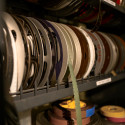Mammoth hose reel slides toward completion
Built on runners, equipment destined for polar project

Really big reel
Instrument maker Bart Dana, above, removes a level winder arm from a 10-ton hose reel and sledge under construction at UW–Madison’s Physical Science Laboratory. They are components of a drilling system to be used to construct IceCube, a neutrino telescope to be built at the South Pole. When deployed, the hot-water rig will be used to drill kilometer-deep holes in the Antarctic ice so that strings of photomultiplier tubes — the heart of the IceCube detector array — can be sunk into the ice. (Photo: Michael Forster Rothbart)
It’s big. It’s on runners. It will soon be painted bright red. And it’s headed for the Pole.
But it’s not loaded with toys, and instead of being drawn by eight tiny reindeer to the North Pole, this sled — which carries a mammoth hose reel as part of a unique cold-climate drilling rig — is destined for the South Pole via Air Force C-130 where it will help lay the groundwork for a novel telescope.
When completed, the 23-ton hose reel and steel sledge on which it is mounted, will carry more than 2.5 kilometers of three-and-three-quarter-inch diameter hose. It will be used as part of hot-water ice drilling rig, now under construction at UW–Madison’s Physical Sciences Laboratory (PSL), that will help scientists knife through more than a kilometer of polar ice as part of a project to build a giant neutrino telescope, to be known as Ice Cube.
Funded by the National Science Foundation, Ice Cube will be the world’s first true high-energy neutrino telescope, capable, scientists hope, of detecting the ghost-like subatomic particles that promise a new window to some of the most distant and violent events in the universe. But to build the telescope, scientists must first drill as many as 80 2.5-kilometer-deep holes in the polar ice to deploy strings of photomultiplier tubes (PMTs) that will help transform the Antarctic ice into an enormous detector that will be the heart of the telescope.
“Without the hose reel … no neutrinos, it is as simple as that,” said Francis Halzen, a UW–Madison professor of physics and a leader of the Ice Cube project. “A high performance drill working reliably is necessary for a timely completion of the project. We only have a two-month shot at construction every year and the drill has to be perfect.”
The Titanic hose reel and it’s sledge with three steel runners, according to PSL Technical Director Farshid Feyzi, will be flown next fall to the South Pole and assembled in place. When assembled, it will be towed by a tracked vehicle and will be part of a drilling system that will include pumping, heater and control system sheds, as well as a tower for deploying the drilling hose and a well where subsurface ice will be melted to create an underground reservoir of water to be heated and used for the Ice Cube drilling effort.
“The drilling camp is quite a large operation,” said Feyzi noting that the one-of-a-kind hose reel is a linchpin of the effort. “If this system fails, everything stops. The other parts of the system have some redundancy.”
To meet the challenge of operating in an environment where temperatures can plunge to -40 Fahrenheit, the hose reel system is as simple and as durable as it can be, said PSL Director David Huber. “You have to think about assembly. You have to make sure there are not a lot of small parts and that it is easy to put together. There’s no Fed Ex delivery if a part fails and you can’t run out to Home Depot for a spare.”
When completed and deployed to the South Pole next year, the drilling system will blast holes in the polar ice using near boiling water pumped through stiff three-and three-quarter-inch hose at 200 gallons a minute.
The drilling system is warmed with alcohol so it won’t freeze, said Feyzi. It’s tricky because of the extremely low temperatures at the pole and and the fact that water is used to drill the deep holes for Ice Cube. Even when heated to near boiling temperatures, it can quickly refreeze and stall the drilling operation.
The large hose reel under construction at PSL is one of the largest projects to be undertaken by the laboratory, which designs and constructs unique scientific equipment, equipment that tends to be one of a kind and that can’t be bought off the shelf.
Under the current construction timeline for Ice Cube, the large hose reel will be in use at the South Pole for at least five seasons as scientists drill16 holes per season to deploy as many as 4,800 PMTs that will make up the telescope’s detector array.
Tags: research




